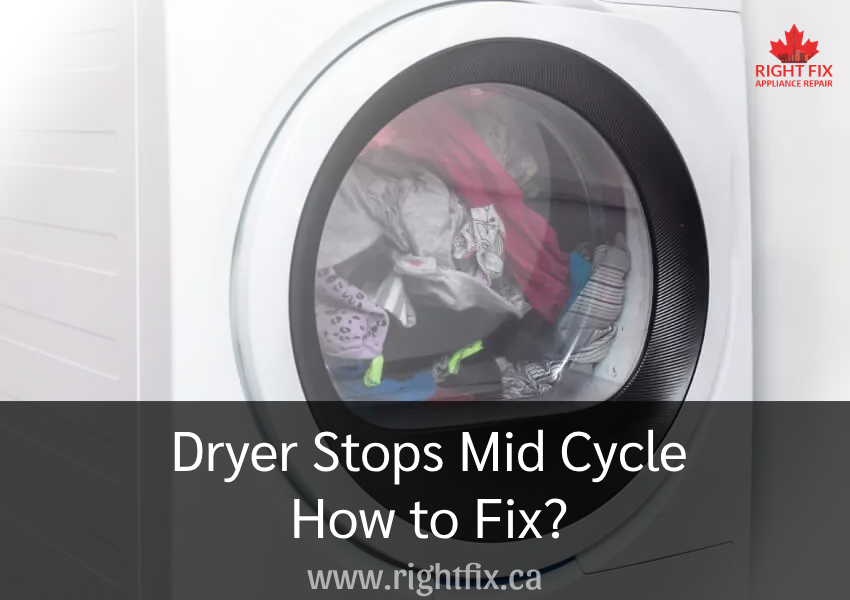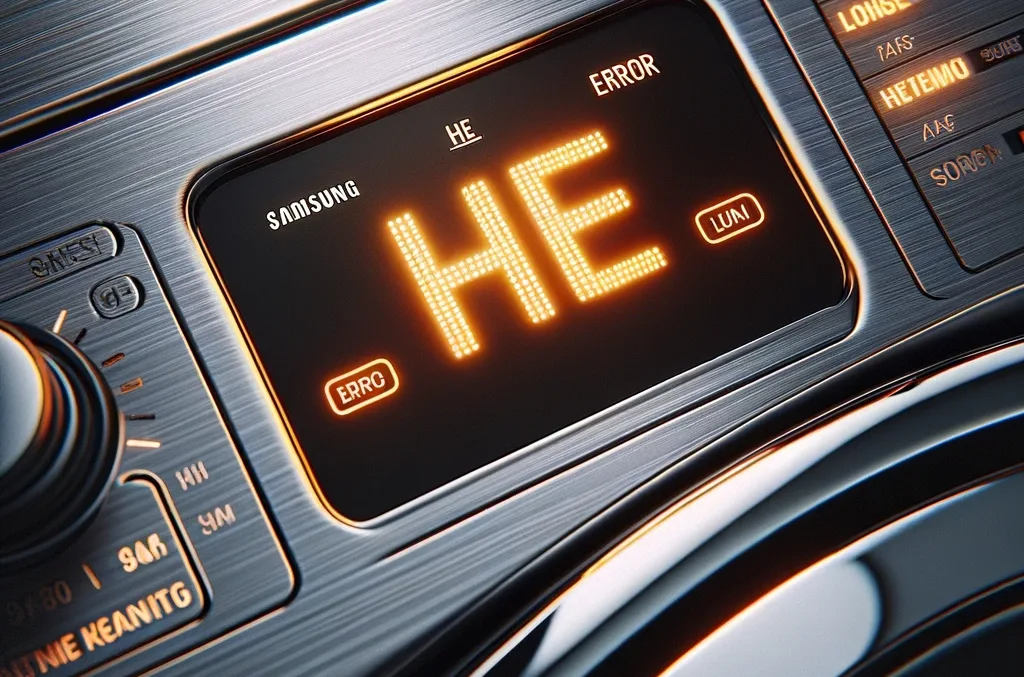Dryer Stops Mid Cycle – How to Fix?
Especially when your laundry schedule is disrupted, a dryer that stops midway-cycle may be rather annoying. From a basic blocked vent to more major mechanical breakdowns, it might result from a number of underlying problems. Knowing the possible reasons and treatments will enable you to save time and prevent pointless repair expenses. This tutorial will go over why a dryer could stop mid-cycle and how you might fix the problem to have your dryer running as it should. Contact professional dryer repair technician from RightFix.
Possible Reasons for Mid-Cycle Dryer Stopping
Overheating Result of Restricted Ventilation
Often resulting from obstructed ventilation, overheating is one of the most prevalent causes of a dryer stopping mid-cycle. Lint or trash builds in the vent system of the dryer, therefore limiting airflow. The dryer overheats so, activating an automated shut-off to stop a fire. Though it stops heating, you might find the dryer drum still turning. Although this overheating safety system is essential to avoid dangerous conditions, if neglected it can also lead to unneeded shutdowns.
Malfunctioning Thermostat
Your dryer's thermostat controls temperature to make sure the machine never overheats. Should the thermostat be defective or malfunctioning, it might fail to detect the proper temperature, which would cause the dryer to turn off in case of precaution. Because it may warn the machine to cease power early on, a damaged or worn-out thermostat might cause your dryer to stop running mid-cycle.
Blown Thermal Fuse in Action
Most dryers also have a thermal fuse, which, should the dryer get too hot, turns off the electrical supply to the heating element. Usually, a blown thermal fuse causes the dryer to stop heating, therefore producing partial drying cycles. Common in several dryer brands, including LG, Whirlpool, Kenmore, and Samsung, this problem is Should your dryer routinely turn off mid-cycle, the thermal fuse might be the cause.
Broken heating element
Generating the hot air required to dry your clothing falls to the heating element. Should this part break, the dryer can turn off mid-cycle as it cannot efficiently heat the air. Although the dryer drum could continue spin, the absence of heat will cause the machine to stop operating as intended. Often times, a malfunctioning heating element results in a lack of heat even on a running dryer.
Problems with Motors
Your dryer's motor runs the drum and blower. Should the motor be overused or starting to fail, it might overheat and halt the dryer. Older dryers or those used repeatedly often have this specific commonality. Before the dryer shuts off, a motor issue could also show themselves as unusual noises or grinding sounds. Sometimes the engine may have to cool before the dryer can be turned on again.
Malfunctioning door switch
The door switch guarantees that the dryer will run only when the door is tightly closed. Should this switch be defective or misaligned, the dryer might stop mid-cycle as it perceives an open door erroneously. Sometimes a totally damaged door switch causes the dryer to not start at all.
Errors in the Control Board
Your dryer's control board controls cycle settings, heat levels, and timing among other things. Should the control board malfunction, your dryer might fail to run entire cycles or turn off on demand. Since control board problems are more complicated, diagnosis of them usually calls for expert help.
Bad Moisture Sensor
Moisture sensors built into modern dryers help them to identify when clothing are dry. A faulty sensor could falsely indicate that the laundry is dry, therefore triggering early shutdown of the dryer. The moisture sensor may be malfunctioning if your dryer shuts off mid-cycle even if the cloths remain damp.
How to Repair a Dryer Stopped in Mid-Cycle
Exchanged Filters and Vent Openings
-
Safety calls for unplugging the dryer before cleaning.
-
After each load, empty the lint trap.
-
To guarantee correct airflow, check and clean the exhaust duct.
-
Look into the vent ports for any obstructions; remove them as necessary.
-
Maintaining airflow often helps to prevent overheating.
Inspect and replace broken parts.
-
Look at the thermal fuse for any damage; repair as necessary.
-
Verify the thermostat's operation to be sure it is accurate.
-
Look at the heating element for wear or breakage; replace if it is broken.
-
See a professional repair company for difficult problems such broken control boards or defective door switches.
Frequent Maintenance
-
After every drier cycle, clean the lint trap.
-
At least once a year, look over the venting system and clear any accumulation.
-
For evidence of wear or damage, routinely inspect the seals, motor components, and belts.
-
Plan yearly maintenance to avoid any mid-cycle interruptions.
When Should I See a Professional?
See a professional repair facility if troubleshooting efforts fail to fix the problem. For difficult issues including motor failures or control board failures, consult experts. Use the dryer only once the problem is resolved to avoid more damage and costly repairs.
Preventive Actions to Preventer of Dryer Issues
Correct Load for Laundry
Overloading your dryer might cause too much pressure on its engine and components, which would cause early breakdowns. See the manufacturer's recommendations on load size. This will increase the lifetime of your machine in addition to stop your dryer from halting mid-cycle.
Apply Suggested Settings
Always dry your items at the suggested settings for their kind. For example, whilst larger objects can demand more heat, delicate materials need for reduced heat levels. Incorrect setup might result in overheating or sensor failures, which would disrupt cycles.
Frequent Equipment Inspection Programs
Apart from maintaining the lint filter and vent, you should plan frequent visits to your dryer. This covers belt wear, gasket and seal inspection. Early detection of problems helps to avoid main causes of mid-cycle stoppages.
In summary
From obstructed ventilation to malfunctioning thermostats or heating elements, several things might cause a dryer that pauses mid-cycle. Your dryer will remain functioning effectively if you know the possible causes and act preventively. Should basic repairs fail, think about consulting an expert to check and fix your computer. Avoiding these problems and guarantees your dryer runs for years to come by means of regular maintenance.
Therefore, addressing common issues will save you time, effort, and perhaps costly repairs whether your LG dryer stops mid-cycle or you're asking "why does my GE dryer keep shutting off."
REFERENCES
- TeGrotenhuis, Ward E. Clothes Dryer Automatic Termination Evaluation. No. PNNL-23616. Pacific Northwest National Lab.(PNNL), Richland, WA (United States), 2014. https://www.osti.gov/biblio/1159793
- Bansal, Pradeep, Amar Mohabir, and William Miller. “A novel method to determine air leakage in heat pump clothes dryers.” Energy 96 (2016): 1-7. https://www.sciencedirect.com/science/article/abs/pii/S036054421501693X
Location we Service
- Ajax
- Alliston
- Aurora
- Bolton
- Bradford
- Brampton
- Brantford
- Burlington
- Caledon
- Cambridge
- Concord
- East York
- Etobicoke
- Georgetown
- GTA
- Guelph
- Halton Hills
- Hamilton
- Innisfil
- Keswick
- King City
- Kitchener
- Kleinburg
- Maple
- Markham
- Milton
- Mississauga
- New Tecumseth
- Newmarket
- North York
- Oakville
- Orangeville
- Oshawa
- Pickering
- Richmond Hill
- Scarborough
- Schomberg
- Stouffville
- Thornhill
- Toronto
- Unionville
- Uxbridge
- Vaughan
- Waterloo
- Whitby
- Woodbridge


























